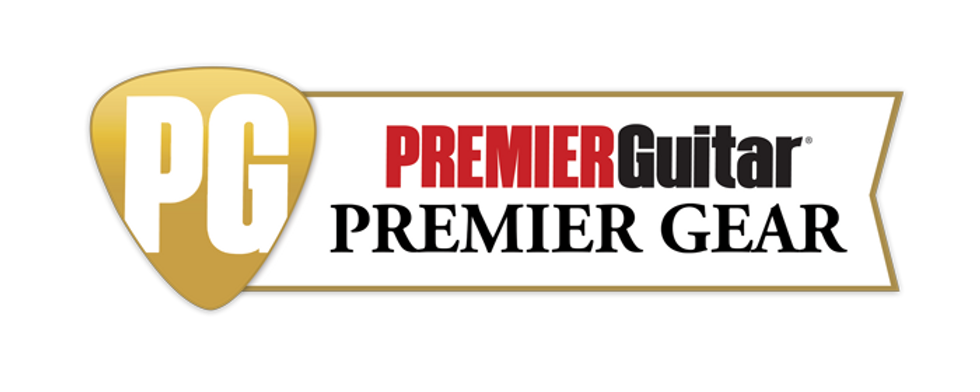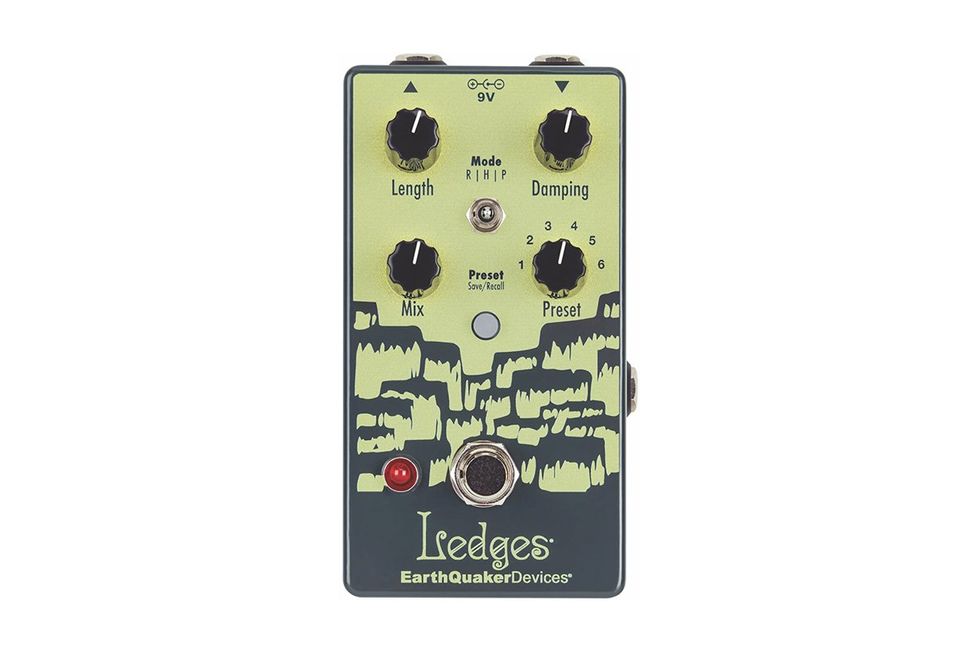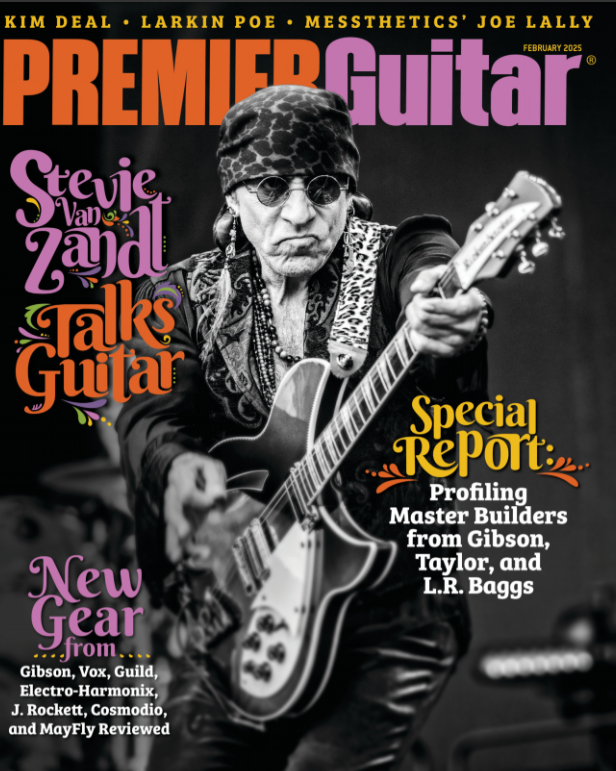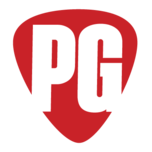Love varied reverb texture and presets but hate complex preset maneuvers? Well, meet your new best friend.
Simple-to-set-and-access presets. Great thickening ambience at modest settings. Effective damping control.
Some saccharine overtones in long reverbs—even with damping.
$199
EarthQuaker Devices Ledges
earthquakerdevices.com

I’d guess that when many people consider EarthQuaker and reverb in the same breath, they imagine devices from the wilder side of the effects spectrum. Certainly, EQD built their share of these. Reverbs like the Transmisser, Astral Destiny, and Afterneath are famous for their ability to mix modulation, octave content, or filtering effects with reverb and then propel those sounds ever skyward. But EarthQuaker is equally adept at building practical reverbs. The ultra-utilitarian Dispatch Master is one of the company’s best sellers. The discontinued Levitation moved from modest reverbs to extra-ethereal spaces with ease. And the Ghost Echo lives in the relatively pedestrian realm of digital spring-style reverb.
The new Ledges, which combines room-, hall-, and plate-style voices, fits very neatly on the practical side of the EarthQuaker reverb family. But that does not mean it is timid by any stretch. Indeed, one of the most practical facets of Ledges’ design is how readily you can move from reverb that’s barely there to interstellar realms.
Streamliner to Space
Ledges walks a middle ground between complex pedals with multiple modes, voices, and presets, and more streamlined, what-you-see-is-what-you-get stompboxes. Everything you need to summon the whole of Ledges’ expansive reverb vocabulary is right there on the face of the pedal. Six presets are saved and selected via a small, illuminated save/recall button that’s adjacent to the rotary preset selector switch. To save a preset, you merely set the other controls to preferred positions, select a preset position on the preset knob, and hold down the save/recall button. That’s it. There are no tricky multi-tap-hold-and-twist maneuvers to navigate. It’s dead simple and it’s beautiful.
Ledges’ remaining four controls are a wet/dry mix control, a reverb-length knob, a treble-damping control, and a 3-position toggle that selects room, hall, or plate reverbs. There’s also an expression pedal jack, and you can assign any settings to an expression pedal (and save them within a preset) using a quick two-step sequence.
From My Room, I Dreamed of the Stars
Room mode is great for adding body as much as ambience to your guitar signal. Even at bassier damping settings, it gives a guitar a fuller, airier essence. It’s great for adding heft to a Stratocaster pickup without sacrificing its essential Stratiness, or, at less damped settings, giving the top end of a humbucker’s signal a little more top-end life. Using less damping and a more aggressive mix can approximate the reflections of tile surfaces, or, with longer tails, a small gymnasium. These reverb settings are beautiful for pairing with a clear but overdriven guitar signal, or with a quick, tape-style echo for old-school reggae or rhythm and blues studio ambience.
”There are no tricky multi-tap-hold-and-twist maneuvers to navigate. It’s dead simple and it’s beautiful.“
The most modest hall settings start where the most ambient room settings leave off. But there is a sense of just-right size and body in the hall mode, particularly at mellow length and mix settings. In this range you can find pretty alternatives to amplifier spring reverbs that offer many similar overtones without the splashy clang of a spring. It’s a tasteful but robust sound that situates itself with ease in a mix, and will likely make you popular with bandmates and recording engineers. It doesn’t take much extra length, though, before the hall takes on cave-like proportions. It’s good to mind your damping and mix settings here. But a little extra top end from the damping control can add pretty, almost harmonizing overtones.
The plate setting, to my ears, sounds magnificent with all the knobs parked at 10 o’clock. Here, clean guitars become big but tasteful in ways that can fill and transform a song—making chords a beautiful bed for accompanying instruments and giving lead lines sweet resonance. But the plate setting is also home to preposterously long and near-infinite reverbs that can turn a single chord into a bed for whole extended verses. Without the damping setting, many of these reverberations might sound cloying in the top end. And some sugary overtones can remain if you don’t get that setting right. But if you consider the way these extreme options enable a move from a very subdued reverb to a preposterously expansive one—just with the flick of the preset switch—you start to see the performance potential Ledges has to offer.
The Verdict
Ledges gracefully straddles the line between utility and access to outsized ambience. It’s an incredibly practical stage and performance tool that can move between many moods, modes, and identities in a set with reassuring ease. EarthQuaker definitely hit the easy-to-use mark here. Not surprisingly, they created a very satisfying palette of sounds to work with, too
- DIY: How to Repair a Wet Pedal ›
- PG Explains: Pedals/Effects ›
- What You Should Know Before Using Guitar Pedals with Other Instruments ›
The Archon Classic is not a re-issue of the original Archon, but a newly voiced circuit with the Lead channel excelling in 70s and 80s rock tones and a hotter Clean channel able to go into breakup. This is the answer for those wanting an Archon with a hotrod vintage Lead channel gain structure without changing preamp tube types and a juiced up Clean channel without having to use a boost pedal all wrapped up in a retro inspired cabinet design." - Doug Sewell, PRS Amp Designer
A fine-tuned, well-worn feel, noiseless pickups, and a broad tone vocabulary made possible by clever switching mark real refinement in Player II Modified versions of Fullerton’s foundational designs.
- Noiseless single-coil pickups – Classic Fender tone without hum
- Higher-output humbucker – More power with articulate midrange bite
- Push-pull switching – Expands tonal versatility by splitting humbuckers
- Treble bleed circuit – Maintains clarity when rolling back volume
- Modern “C” neck with rolled edges – Smooth, broken-in feel for effortless playability
- Redesigned active preamp (basses) – Improved tone control with enhanced midrange
- Upgraded bridges, locking tuners, and TUSQ nut – Better tuning stability, sustain, and intonation
In this episode of 100 Guitarists, we’re talking all things surf rock, from reverb to tremolo picking and much more. And while “Misrlou” is undisputedly his most influential work, maybe Dale’s best records didn’t come until a few decades later.
“All the kids in all L.A. / Come to hear Dick Dale play,” or so goes the title track from Dick Dale’s Wrecking Crew-heavy 1963 album, King of the Surf Guitar. Immodest though it might seem to proclaim such a status, he was indeed at the top of the heap.
For many, Dale’s legend precedes him. His sound, first heard in a So Cal beach ballroom, created the surf guitar vocabulary and transformed the guitar universe, starting with the 1962 release of his take on the traditional song “Misrlou.” Ever the showman, he worked closely with Leo Fender developing the right gear for the gig as he played his ripping instrumentals to larger and larger audiences. He also inspired a Hendrix lyric and had a late-career renaissance thanks to Quentin Tarantino.
In this episode of 100 Guitarists, we’re talking all things surf rock, from reverb to tremolo picking and much more. And while “Misrlou” is undisputedly his most influential work, maybe Dale’s best records didn’t come until a few decades later.

This episode is sponsored byTraveler Guitar.
Fabulous neck with just-right fatness. Distinctive tone profile. Smooth, stable vibrato. Ice blue metallic and aluminum look delish together.
Higher output pickups could turn off Fender-geared traditionalists.
$939
Eastman FullerTone DC’62
An affordable version of Eastman’s U.S.-made solidbody rolls with unique, well-executed features—at a price and quality level that rivals very tough competition.
Eastman’s instruments regularly impress in terms ofquality and performance. A few left my PG colleagues downright smitten. But if Eastman isn’t a household name among guitarists, it might be a case of consumer psychology: Relative to most instruments built in China, Eastmans are expensive. So, if you spend your life longing for a Gibson 335 and a comparable (if superficially fancier) Eastman costs just 20 percent less than the least expensive version of the real deal, why not save up for a bit longer and get the guitar of your dreams?
For some players, though, such brand-devotional hang ups are obstacles to getting the best instrument for the best price. Some just like having an alternative to legacy brands and models that live as dreams in a zillion other heads. As Eastman evolved as a company, they’ve paid close attention to both of those market segments—creating refined original designs like the El Rey and Romeo while keeping quality, execution, and playability at an exceptional standard. With the introduction of the FullerTone instruments, a series of Beijing-built guitars modeled after Eastman’s California-built, Otto D’Ambrosio-designed solidbodies, Eastman’s price/performance goals reach a kind of apex. Because the FullerTone guitars aren’t archtops or thinlines and use bolt-on necks, they range from just $799 (for the simpler SC’52) to $899 (for the more full-featured DC’62 reviewed here). That’s a competitive market bracket, to say the least, but Fullertone delivers the goods in ways that count to players.
Somewhere in an Alternate O.C….
You don’t need to be a certified Mensa member to suss the FullerTone’s design benchmarks. The name’s likeness to that of an Orange County locale where historically important electric guitar design took place is a less-than-covert tip of the hat. More tangible evidence of the DC’62’s Stratocaster inspirations exist in the shape of a bolt-on, 25.5"-scale neck, six-on-a-side headstock, a curvaceous double-cut body, and vibrato. (The more Telecaster-like DC’52 uses a T-style bridge and comes sans vibrato).
Many of these design nods, however, are distinguished by Eastman’s refinements. The patented neck joint, for instance, mimics that of the upmarket, U.S.-built Eastman D’Ambrosio. It employs just two screws, bolted into steel anchors in the neck itself. It’s a robust, clever design. The joint, which works in part like a long tenon, provides extra neck-to-body contact, making the effortless access to all 24 medium-jumbo frets all the more remarkable. (The fretwork, by the way, is impeccable).
“The neck’s profile will pique the interest of anyone bored with the sameness of generic, modern C-profiles.”
The neck itself—roasted maple, satin-finished, and capped with a 12"-radius Indian rosewood fretboard—uses an angled headstock design that differs from Fender convention, but the break angle is much shallower than a Gibson, which aids tuning stability. The neck’s profile, though, will pique the interest of anyone bored with the sameness of generic, modern C-profiles. Eastman calls it a medium-round profile, but that doesn’t do justice to its substance, which calls to mind Fender’s chunkier 1960s necks. It’s not a shape for everyone, and shredders and players with really petite hands might be less enthused, but it’s exceptionally comfortable, fills the palm naturally, and, at least for me, induces less fatigue than slimmer necks.
The Strat-style vibrato is a smart, functional evolution of a classic form. The arm sits securely in a rubber sleeve that keeps it precisely where you want, and the bridge itself is fixed to a substantial brass block and features individually intonatable saddles. The vibrato is so smooth and tuning stable that you will want to use it often. Really aggressive, twitchy vibrato technique can produce knocking against the body as you pitch up—at least as it’s set up at the factory. Otherwise, it’s fun and forgiving to use.
I would be remiss, by the way, if I didn’t mention how good the black limba body looks in satin ice blue metallic with a brushed aluminum pickguard. Though the DC’62 is available in black and desert sand (the latter with gold anodized pickguard), this particular combination is beautiful, elegant, and tasteful in a way that accentuates D’Ambrosio’s timeless lines.
Substantially Yours
The DC’62’s pickups are produced by Tonerider, and they include two stacked noiseless alnico 5 single-coils in the center and neck positions (measuring 7.9 ohms) as well as an alnico 2 unit, also measuring 7.9 ohms, that Eastman calls a “soapbar humbucker with gold-foil cover.” That’s a curious mash up of nomenclature. Traditionally, “soapbar” pickups are P-90s, which are single-coils, and though the gold-foil-style cover looks cool, it doesn’t lend any gold-foil-ness in terms of construction. Tone-wise it inhabits a unique place. Some aspects of its response evoke a Stratocaster bridge pickup rendered large. There are also hints of a Telecaster bridge unit’s meatiness. But of all the pickups I compared it to (at one point there was an SG, Telecaster, Wide Range-equipped Telecaster Deluxe, Stratocaster, and J Mascis Jazzmaster strewn about the room), it sounds most like a Rickenbacker Hi-Gain in an ’80s 330. That’s cool. I think Hi-Gains are underrated and sound fabulous. But the Tonerider unit is definitely not an S-type pickup in any traditional sense. The stacked single-coils, too, deviate significantly from the Stratocaster’s sonic mold. They are noiseless, as advertised, but have heat and push that make a vintage S-style pickup sound glassy and comparatively thin.
The Verdict
With a fantastic neck, smooth playability, and tuning stability that keep you glued to the instrument, the top-quality DC’62 is flat-out fun to play, which is good, given that at $899 it’s in a price class with Fender’s excellent Mexico-made Player II guitars and PRS’s superlative SE series, to name a few. But the DC’62 offers a unique palette of tones that don’t fit neatly into any box, and with a shape that breaks from tradition, it’s a competitively priced way to take sonic and stylistic paths much less trodden










